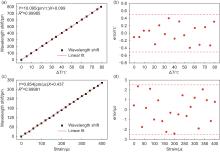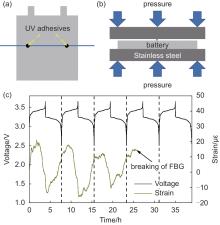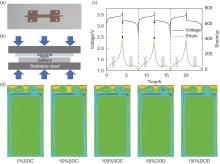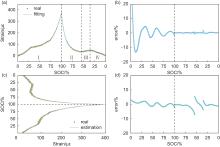Energy Storage Science and Technology ›› 2025, Vol. 14 ›› Issue (1): 310-318.doi: 10.19799/j.cnki.2095-4239.2024.0653
• Energy Storage Test: Methods and Evaluation • Previous Articles Next Articles
Jinqiao DU1( ), Yi ZHANG2, Jie TIAN1, Kai HUANG2, Yue SHEN2(
), Yi ZHANG2, Jie TIAN1, Kai HUANG2, Yue SHEN2( )
)
Received:2024-07-15
Revised:2024-08-19
Online:2025-01-28
Published:2025-02-25
Contact:
Yue SHEN
E-mail:jinqiaodu@qq.com;shenyue1213@hust.edu.cn
CLC Number:
Jinqiao DU, Yi ZHANG, Jie TIAN, Kai HUANG, Yue SHEN. Strain evolution and state of charge estimation in graphite-lithium iron phosphate pouch cells during cycling[J]. Energy Storage Science and Technology, 2025, 14(1): 310-318.

Fig. 2
Sensitivity coefficient of the FBG sensor: (a) The actual and fitted Bragg wavelength shift vary with the temperature within the range of 80℃; (b) The error between the fitting value and the experimental value of Bragg wavelength for temperature; (c) The actual and fitted Bragg wavelength shift vary with the strain within the range of 400 με; (d) The error between the fitting value and the experimental value of Bragg wavelength for strain"


Fig. 3
Direct encapsulation method for FBG sensor and the pouch cell and the testing result: (a) (b) The schematic diagram of the encapsulation for FBG sensor and the pouch cell; (c) Time-resolved voltage and strain profiles of the pouch cell, in which the optical fiber broke after 25 h and the optical signal disappeared"


Fig. 4
The encapsulation method for FBG sensor and the pouch cell based on strain gauges made of FBG sensor and the testing result: (a) (b) The structure of the designed strain gauge made of FBG sensor and the schematic diagram of the encapsulation method for FBG sensor and the pouch cell; (c) Time-resolved voltage and strain profiles of the pouch cell; (d) Ultrasonic scanning transmission image of soft pack battery under different SOC"


Fig. 7
The SOC estimation of the pouch cell by strain signal: (a) The piecewise fitting correspondence between strain and SOC; (b) The error of the fitting model; (c) Comparison of the actual SOC in (n+1)th circle with the SOC calculated by the fitting model; (d) The error of SOC estimation by the strain signal"

| 1 | ZHU Z X, JIANG T L, ALI M, et al. Rechargeable batteries for grid scale energy storage[J]. Chemical Reviews, 2022, 122(22): 16610-16751. DOI: 10.1021/acs.chemrev.2c00289. |
| 2 | XIA X N, LI P W, XIA Z G, et al. Life cycle carbon footprint of electric vehicles in different countries: A review[J]. Separation and Purification Technology, 2022, 301: 122063. DOI: 10.1016/j.seppur.2022.122063. |
| 3 | HUANG Y M, LI J. Key challenges for grid-scale lithium-ion battery energy storage[J]. Advanced Energy Materials, 2022, 12(48): 2202197. DOI: 10.1002/aenm.202202197. |
| 4 | MEI W X, LIU Z, WANG C D, et al. Operando monitoring of thermal runaway in commercial lithium-ion cells via advanced lab-on-fiber technologies[J]. Nature Communications, 2023, 14(1): 5251. DOI: 10.1038/s41467-023-40995-3. |
| 5 | DUAN J, TANG X, DAI H F, et al. Building safe lithium-ion batteries for electric vehicles: A review[J]. Electrochemical Energy Reviews, 2020, 3(1): 1-42. DOI: 10.1007/s41918-019-00060-4. |
| 6 | ZHANG S C, SHEN Z Y, LU Y Y. Research progress of thermal runaway and safety for lithium metal batteries[J]. Acta Physico Chimica Sinica, 2020, DOI: 10.3866/pku.whxb202008065. |
| 7 | 郝奕帆, 祝夏雨, 王静, 等. 电池无损检测监测方法分析[J]. 储能科学与技术, 2023, 12(5): 1713-1737. DOI: 10.19799/j.cnki.2095-4239.2023.0081. |
| HAO Y F, ZHU X Y, WANG J, et al. Analysis of battery nondestructive testing and monitoring methods[J]. Energy Storage Science and Technology, 2023, 12(5): 1713-1737. DOI: 10.19799/j.cnki.2095-4239.2023.0081. | |
| 8 | 辛耀达, 李娜, 杨乐, 等. 锂离子电池植入传感技术[J]. 储能科学与技术, 2022, 11(6): 1834-1846. DOI: 10.19799/j.cnki.2095-4239.2022.0183. |
| XIN Y D, LI N, YANG L, et al. Integrated sensing technology for lithium ion battery[J]. Energy Storage Science and Technology, 2022, 11(6): 1834-1846. DOI: 10.19799/j.cnki.2095-4239. 2022. 0183. | |
| 9 | ZHANG Y, LI Y P, GUO Z Z, et al. Health monitoring by optical fiber sensing technology for rechargeable batteries[J]. eScience, 2024, 4(1): 100174. DOI: 10.1016/j.esci.2023.100174. |
| 10 | HAN G C, YAN J Z, GUO Z, et al. A review on various optical fibre sensing methods for batteries[J]. Renewable and Sustainable Energy Reviews, 2021, 150: 111514. DOI: 10.1016/j.rser.2021.111514. |
| 11 | LIU X H, ZHANG L S, YU H Q, et al. Bridging multiscale characterization technologies and digital modeling to evaluate lithium battery full lifecycle[J]. Advanced Energy Materials, 2022, 12(33): 2200889. DOI: 10.1002/aenm.202200889. |
| 12 | LI R H, LI W, SINGH A, et al. Effect of external pressure and internal stress on battery performance and lifespan[J]. Energy Storage Materials, 2022, 52: 395-429. DOI: 10.1016/j.ensm. 2022.07.034. |
| 13 | LU X B, TARASCON J M, HUANG J Q. Perspective on commercializing smart sensing for batteries[J]. eTransportation, 2022, 14: 100207. DOI: 10.1016/j.etran.2022.100207. |
| 14 | LU Y, WANG X D, MAO S Y, et al. Smart batteries enabled by implanted flexible sensors[J]. Energy & Environmental Science, 2023, 16(6): 2448-2463. DOI: 10.1039/D3EE00695F. |
| 15 | HAN S Y, LEE C, LEWIS J A, et al. Stress evolution during cycling of alloy-anode solid-state batteries[J]. Joule, 2021, 5(9): 2450-2465. DOI: 10.1016/j.joule.2021.07.002. |
| 16 | XU R Y, XIANG J W, FENG J R, et al. In situ visualization by X-Ray computed tomography on sulfur stabilization and lithium polysulfides immobilization in S@HCS/MnOx cathode[J]. Energy Storage Materials, 2020, 31: 164-171. DOI: 10.1016/j.ensm. 2020.06.011. |
| 17 | MATRAS D, ASHTON T E, DONG H, et al. Emerging chemical heterogeneities in a commercial 18650 NCA Li-ion battery during early cycling revealed by synchrotron X-ray diffraction tomography[J]. Journal of Power Sources, 2022, 539: 231589. DOI: 10.1016/j.jpowsour.2022.231589. |
| 18 | LOULI A J, ELDESOKY A, WEBER R, et al. Diagnosing and correcting anode-free cell failure via electrolyte and morphological analysis[J]. Nature Energy, 2020, 5: 693-702. DOI: 10.1038/s41560-020-0668-8. |
| 19 | SHI X L, SUN Y C, WENG Y B, et al. Operando chemical strain analysis of CNT/VOOH during zinc insertion in Zn-ion batteries[J]. Energy & Environmental Science, 2023, 16(10): 4670-4678. DOI: 10.1039/D3EE01745A. |
| 20 | XU Z Y, SHI X L, ZHUANG X Q, et al. Chemical strain of graphite-based anode during lithiation and delithiation at various temperatures[J]. Research, 2021, 2021: 9842391. DOI: 10.34133/2021/9842391. |
| 21 | LI Y P, ZHANG Y, LI Z, et al. Operando decoding of surface strain in anode-free lithium metal batteries via optical fiber sensor[J]. Advanced Science, 2022, 9(26): e2203247. DOI: 10.1002/advs. 202203247. |
| 22 | ALBERO BLANQUER L, MARCHINI F, SEITZ J R, et al. Optical sensors for operando stress monitoring in lithium-based batteries containing solid-state or liquid electrolytes[J]. Nature Communications, 2022, 13(1): 1153. DOI: 10.1038/s41467-022-28792-w. |
| 23 | ZHANG Y, XIAO X P, CHEN W L, et al. In operando monitoring the stress evolution of silicon anode electrodes during battery operation via optical fiber sensors[J]. Small, 2024, 20(29): e2311299. DOI: 10.1002/smll.202311299. |
| 24 | LU P, MEN L Q, SOOLEY K, et al. Tapered fiber Mach-Zehnder interferometer for simultaneous measurement of refractive index and temperature[J]. Applied Physics Letters, 2009, 94(13): 131110. DOI: 10.1063/1.3115029. |
| 25 | BAE C J, MANANDHAR A, KIESEL P, et al. Monitoring the strain evolution of lithium-ion battery electrodes using an optical fiber Bragg grating sensor[J]. Energy Technology, 2016, 4(7): 851-855. DOI: 10.1002/ente.201500514. |
| 26 | MIAO Z Y, LI Y P, XIAO X P, et al. Direct optical fiber monitor on stress evolution of the sulfur-based cathodes for lithium–sulfur batteries[J]. Energy & Environmental Science, 2022, 15(5): 2029-2038. DOI: 10.1039/D2EE00007E. |
| 27 | DENG Z, HUANG Z Y, SHEN Y, et al. Ultrasonic scanning to observe wetting and "unwetting" in Li-ion pouch cells[J]. Joule, 2020, 4(9): 2017-2029. DOI: 10.1016/j.joule.2020.07.014. |
| 28 | HUO H Y, HUANG K, LUO W, et al. Evaluating interfacial stability in solid-state pouch cells via ultrasonic imaging[J]. ACS Energy Letters, 2022, 7(2): 650-658. DOI: 10.1021/acsenergylett.1c02363. |
| 29 | 邓哲, 黄震宇, 刘磊, 等. 超声技术在锂离子电池表征中的应用[J]. 储能科学与技术, 2019, 8(6): 1033-1039. DOI: 10.12028/j.issn.2095-4239.2019.0146. |
| DENG Z, HUANG Z Y, LIU L, et al. Applications of ultrasound technique in characterization of lithium-ion batteries[J]. Energy Storage Science and Technology, 2019, 8(6): 1033-1039. DOI: 10.12028/j.issn.2095-4239.2019.0146. | |
| 30 | DE VASCONCELOS L S, XU R, XU Z R, et al. Chemomechanics of rechargeable batteries: Status, theories, and perspectives[J]. Chemical Reviews, 2022, 122(15): 13043-13107. DOI: 10.1021/acs.chemrev.2c00002. |
| 31 | \VSIMIĆ N, JODLBAUER A, OBERAIGNER M, et al. Phase transitions and ion transport in lithium iron phosphate by atomic-scale analysis to elucidate insertion and extraction processes in Li-ion batteries[J]. Advanced Energy Materials, 2024, 14(34): 2304381. DOI: 10.1002/aenm.202304381. |
| 32 | LOULI A J, ELLIS L D, DAHN J R. Operando pressure measurements reveal solid electrolyte interphase growth to rank Li-ion cell performance[J]. Joule, 2019, 3(3): 745-761. DOI: 10.1016/j.joule.2018.12.009. |
| 33 | LOULI A J, LI J, TRUSSLER S, et al. Volume, pressure and thickness evolution of Li-ion pouch cells with silicon-composite negative electrodes[J]. Journal of the Electrochemical Society, 2017, 164(12): A2689-A2696. DOI: 10.1149/2.1691712jes. |
| [1] | Jianru ZHANG, Qiyu WANG, Qinghao LI, Xianying ZHANG, Bitong WANG, Xiqian YU, Hong LI. Physical characterization techniques and applications in lithium battery failure analysis [J]. Energy Storage Science and Technology, 2025, 14(1): 286-309. |
| [2] | Fanfeng LIU, Tingting WU, Shengyao WEN, Jianhang GAO, Meng CHEN, Chi LI. A study on dissolution of transition metal ions and influence on the cycling performance of LiMn0.6Fe0.4PO4 [J]. Energy Storage Science and Technology, 2025, 14(1): 13-20. |
| [3] | Wenjing ZHANG, Wei XIAO, Yahui YI, Liqin QIAN. Progress on safety modification strategies for lithium-ion batteries [J]. Energy Storage Science and Technology, 2025, 14(1): 104-123. |
| [4] | Yijie YAO, Junwei ZHANG, Yanjun ZHAO, Hongcheng LIANG, Dongni ZHAO. Effect of interfacial dynamics on low temperature performance of sodium-ion batteries [J]. Energy Storage Science and Technology, 2025, 14(1): 30-41. |
| [5] | Cuihong ZENG, Xiujuan CHEN, Man LI, Wenji YIN, Jiming PENG, Sijiang HU, Youguo HUANG, Hongqiang WANG, Qingyu LI. Investigation of W-doped P2-Na0.6Li0.27Mn0.73O2 cathode materials for sodium-ion batteries [J]. Energy Storage Science and Technology, 2024, 13(11): 3731-3741. |
| [6] | Shirong TAN, Wenji YIN, Cuihong ZENG, Xiaoqiong LI, Shuo QI, Fangli JI, Sijiang HU, Hongqiang WANG, Qingyu LI. Role of high temperature quenching in structure and performance of Mn-based layered cathode materials for sodium-ion batteries [J]. Energy Storage Science and Technology, 2024, 13(7): 2399-2406. |
| [7] | Renchao FENG, Yu DONG, Xinyu ZHU, Cai LIU, Sheng CHEN, Da LI, Ruoyu GUO, Bin WANG, Jionghui WANG, Ning LI, Yuefeng SU, Feng WU. Research progress on graphite oxide-based anodes for sodium-ion batteries [J]. Energy Storage Science and Technology, 2024, 13(6): 1835-1848. |
| [8] | Zhaocai LYU, Yuxi WANG, Zhitao WANG, Xiaohui SUN, Jingkang LI. Influence of heated calendering process on cathode film performance of lithium-ion batteries [J]. Energy Storage Science and Technology, 2024, 13(5): 1443-1450. |
| [9] | Min SHI, Pengjie JIANG, Chen XU, Xin HE, Xiao LIANG. Advancements in electrolyte optimization strategies for inhibiting lithium dendrite growth [J]. Energy Storage Science and Technology, 2024, 13(5): 1620-1634. |
| [10] | Yimei OUYANG, Mengmeng ZHAO, Guiming ZHONG, Zhangquan PENG. Nuclear magnetic resonance spectroscopy for probing interfaces in electrochemical energy storage systems [J]. Energy Storage Science and Technology, 2024, 13(1): 157-166. |
| [11] | Qingfei MENG, Rui YANG, Chenglong JIN, Yuliang CAO, Wenjie LI, Zhou ZHOU, Jiliang WU. Preparation and performance of high-capacity Cr8O21 as a cathode material for lithium batteries [J]. Energy Storage Science and Technology, 2023, 12(10): 3049-3055. |
| [12] | Zhihao LIU, Tong DU, Ruirui LI, Tao DENG. Developments of wide temperature range, high voltage and safe EC-free electrolytes [J]. Energy Storage Science and Technology, 2023, 12(8): 2504-2525. |
| [13] | Kangkang QU, Yahua LIU, Die HONG, Zhaoxi SHEN, Xiaozhao HAN, Xu ZHANG. Research progress on positive electrolytes for neutral aqueous organic redox flow battery [J]. Energy Storage Science and Technology, 2023, 12(5): 1570-1588. |
| [14] | Yongli YI, Ran YU, Wu LI, Yi JIN, Zheren DAI. Preparation of Mo, Al-doped Li7La3Zr2O12-based composite solid electrolyte and performance of all-solid-state batterys [J]. Energy Storage Science and Technology, 2023, 12(5): 1490-1499. |
| [15] | Junpeng GUO, Qi SUN, Yuefang CHEN, Yuwen ZHAO, Huan YANG, Zhijia ZHANG. Preparation of three-dimensional multistage iron oxide/carbon nanofiber integrated electrode and sodium storage performance [J]. Energy Storage Science and Technology, 2023, 12(5): 1469-1479. |
| Viewed | ||||||
|
Full text |
|
|||||
|
Abstract |
|
|||||
